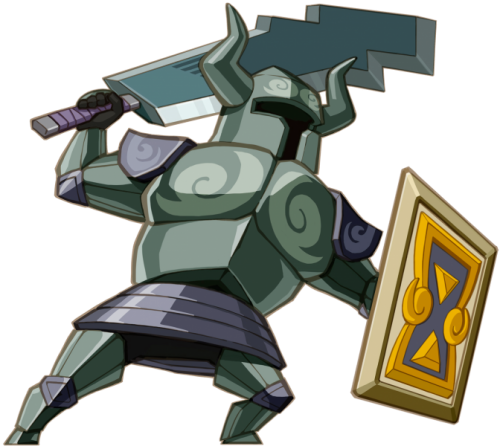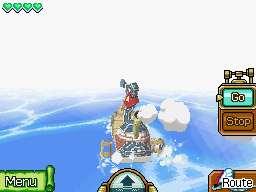Revisiting Phantom Hourglass: Handling Explosives
Posted on February 28 2016 by Mark Olson
 Welcome to the third installment of Revisiting Phantom Hourglass. With the the first dungeon of Phantom Hourglass completed, we make our way to the Isle of Gusts, where the Wind Temple lies. Along the way, we return to the Temple of the Ocean King, discuss bomb controls, and get totally and completely lost in fog.
Welcome to the third installment of Revisiting Phantom Hourglass. With the the first dungeon of Phantom Hourglass completed, we make our way to the Isle of Gusts, where the Wind Temple lies. Along the way, we return to the Temple of the Ocean King, discuss bomb controls, and get totally and completely lost in fog.
Hit the jump for another delve into this DS classic!
After beating the Fire Temple, we are told by Astrid to seek out the other elemental crests, but to find the next one we need to explore an area of the sea that we don’t have a chart for. Thus is introduced the most unequivocally despised aspect of Phantom Hourglass; the backtracking. Now, whether or not this is actually as bad as people make it out to be shall be decided in a later installment.
At the head of this particular visit, we are given the titular timekeeper, the Phantom Hourglass itself. Though later on we will receive more grains of sand to slow down the hourglass’ progress, for now it gives us ten minutes of protection outside the purple safe-zones before the toxic atmosphere of the Temple of the Ocean King begins to siphon away the health bar. Personally speaking, I’ve never liked time limits in my Zelda games. This is for two reasons; firstly, I like to explore every nook and cranny of the game world, and a time limit in any capacity makes me less focused on enjoying the game and more focused on getting through that particular section. Secondly, I am not very good at playing Zelda. The time restriction serves to highlight just how awful I am at execution in Zelda games and, even though the developers almost always give you more than enough time (I had five and a half minutes left after this run through the Temple of the Ocean King), my stress level shoots through the roof. Quite frankly, time limits make the game less fun for me.
 With that aside over, I will say that there was one thing that I enjoyed about this go-round in the Temple of the Ocean King: the phantoms. These guys are awesome; they’re big, imposing, and force you to plan your next move carefully while in the protection of a safe zone. As one of those masochists who has done ghost runs in Dishonored, the addition of this light stealth element was fun. It’s not particularly deep, but even in the early stages of the temple the developers force you to make use of the detection systems in place. At one point, there is a stationary phantom standing right in front of a lever and two purple orbs in the nearby vicinity. Players are forced to slash one of the orbs, causing the phantom to give chase after this mysterious noise. Players can then run to where the phantom was standing and quickly pull the lever that they were guarding. It’s obvious that this moment was carefully choreographed (there’s no other manner to progress to my knowledge), but it still feels like the move was the player’s gambit and that that gambit payed off.
With that aside over, I will say that there was one thing that I enjoyed about this go-round in the Temple of the Ocean King: the phantoms. These guys are awesome; they’re big, imposing, and force you to plan your next move carefully while in the protection of a safe zone. As one of those masochists who has done ghost runs in Dishonored, the addition of this light stealth element was fun. It’s not particularly deep, but even in the early stages of the temple the developers force you to make use of the detection systems in place. At one point, there is a stationary phantom standing right in front of a lever and two purple orbs in the nearby vicinity. Players are forced to slash one of the orbs, causing the phantom to give chase after this mysterious noise. Players can then run to where the phantom was standing and quickly pull the lever that they were guarding. It’s obvious that this moment was carefully choreographed (there’s no other manner to progress to my knowledge), but it still feels like the move was the player’s gambit and that that gambit payed off.
After plumbing the depths of a few more floors, evading a few more phantoms, and solving a few more puzzles, we come across a big chest containing the Northwestern Sea Chart. In order to see where our next port of call shall be, we have to use yet another fun little gimmick, blowing into the microphone, to get rid of a thick coat of dust on the sea chart.
Though it may seem that the game is gearing up to throw us into another dungeon, there is quite a bit of gameplay to go through before we get to the Wind Temple. If you simply try to sail north, a cyclone scoops the ship up and redeposits the SS Linebeck at a random location in the southwestern sea. Ciela suggests that we try another route, but if we try to go west, young man, we make the unpleasant discovery that a cannon is needed to progress. Where to go, then, but the conveniently named Cannon Island?
 After docking at the small island, players are led to a small hovel called Edo’s Garage. Edo’s assistant kindly informs Link that, as a hard working engineer, Edo has locked himself in the back room. However, there is a super-secret back door that can be entranced by braving a dark cave system and bomb garden. The cave system is rather dull, but the bomb garden is a nice choice; it’s always a good idea to introduce new items before they come into use in any serious capacity. While on the topic, it’s worth noting that I adore how the bombs work in Phantom Hourglass. The touchscreen allows players to pinpoint precisely where they would like their bomb to go. In previous games, any action other than placing the bomb in front of you was fraught with uncertainty as to where that bomb was going to land. I, for one, could never quite judge the strength of Link’s throwing arm. With the touchscreen, players can simply tap where they would like the bomb to go and Link will throw it. The touchscreen as a whole has an iffy track record in gameplay, but the bomb controls are an unadulterated victory.
After docking at the small island, players are led to a small hovel called Edo’s Garage. Edo’s assistant kindly informs Link that, as a hard working engineer, Edo has locked himself in the back room. However, there is a super-secret back door that can be entranced by braving a dark cave system and bomb garden. The cave system is rather dull, but the bomb garden is a nice choice; it’s always a good idea to introduce new items before they come into use in any serious capacity. While on the topic, it’s worth noting that I adore how the bombs work in Phantom Hourglass. The touchscreen allows players to pinpoint precisely where they would like their bomb to go. In previous games, any action other than placing the bomb in front of you was fraught with uncertainty as to where that bomb was going to land. I, for one, could never quite judge the strength of Link’s throwing arm. With the touchscreen, players can simply tap where they would like the bomb to go and Link will throw it. The touchscreen as a whole has an iffy track record in gameplay, but the bomb controls are an unadulterated victory.
 In Edo’s garage, Link purchases the cannon for the whopping price of fifty rupees, and, after blasting away some inconvenient rocks, we can be on our way to the Northwest sea. Except, no, we can’t. You see, upon attempting to make our way Northwest. A thick cloud of fog envelopes the SS Linebeck and from the steely blue emerges the Ghost Ship. Linebeck gives chase and we finally end up in the Northwest area of the sea. Finally, off to the Wind Temple! Except, again, we are stuck.
In Edo’s garage, Link purchases the cannon for the whopping price of fifty rupees, and, after blasting away some inconvenient rocks, we can be on our way to the Northwest sea. Except, no, we can’t. You see, upon attempting to make our way Northwest. A thick cloud of fog envelopes the SS Linebeck and from the steely blue emerges the Ghost Ship. Linebeck gives chase and we finally end up in the Northwest area of the sea. Finally, off to the Wind Temple! Except, again, we are stuck.
The cloud of fog is still impeding our vision, and if we try to sail to the Isle of Gusts, we are thrown back to where we entered the Northwest sea. Ciela says that we need to find a special way through the area, and that there was a sailor who lived nearby who supposedly knew a way through. The only island that is close is Molida Isle. On the island is a small village, an inhabitant of which tells us to visit a man named Romano who lives on the outskirts of the village. After some dialogue, we move into a cave system, fight some monsters, and find a shovel. From there, we have to connect the dots given by Romano’s father’s (the sailor we were looking for) journals to find a place to dig to find a hole to find a cave to find a pathway through the northwest sea to find the Isle of Gusts. Whew.
If you couldn’t tell, I’m not a particularly big fan of this section. All of the monsters are easy and, with the exception of bombs, nothing much is introduced. While the previous two sections I looked at moved at a pretty good clip, this section’s pacing is shot, and the latter half just feels like filler. It’s not all for nothing, though- in the next installment, I will finally look at the new area of the sea we get to explore. Hopefully.
What did you think of this section of Phantom Hourglass? As always, leave your own thoughts in the comments.



